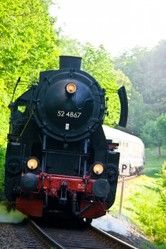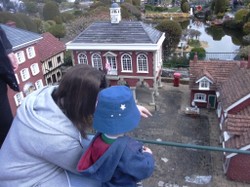Part of the experience of travelling by steam was stopping at the water tower. These were tanks kept constantly replenished by the tracks, where at times we stopped. The fireman, for we had firemen then to stoke the fires, would alight and take the large hose to fill the boiler. I can recall seeing him once as he alighted. We had to wait for the steam pressure to rise again before we could go on our journey, but the fires were kept well-stoked and the delay was not long.Years later we could see forlorn, abandoned water towers by the tracks as the diesel trains that had rendered them redundant sped past. They are gone now, sold as scrap.
Gone also are the old signal boxes, though you still see the occasional one, a fossil from an earlier age, whose innards gather dust in mournful silence. The mechanical signals went with them. We might feel bit nostalgic,but the modern system of lights is an improvement. The modern systems are computer controlled and do the job well. We cannot be Luddites! But there was a charm to steam that the modern system does not possess.
But the sensory memory was the smell. There was at various times the slightly pungent scent of burning coal. It was distinct, the scent that we found in towns with old coal fires before we took to gas. I recall it as the scent of Gorton,the industrial area where I grew up till I was five and where my grandfather had worked at the railway works. The distinct aroma of coal smoke lingers with you throughout the years. You never forget it and even now it evokes childhood memories, though I smell it but seldom now.
Carriages varied then, and sometimes we had compartments that contained only six seats accessed by a corridor, very comfortable and private, but on lonely nights people were vulnerable to assault. These have been discontinued. I liked them, but I can see the point in their discontinuation for safety reasons. But the corridor carriages proved useful in the Second World War for moving German prisoners of war. My father recalled doing so in North Africa, where he nervously sat at the end of the corridor with a bren gun guarding a carriage load of SS troops. These guys were apt to break out and might have to be shot if they did. Fortunately they didn't, so all was well.
Gone also is the tender, the coal wagon that trailed behind the engine from which the fireman shoveled coal into the coal into the furnace. Being a fireman was a hard job that involved great physical effort over the course of a journey. Back home in Stretford I used to talk to an ex-fireman.Years after the last steam engine was decommissioned he was still employed as a ticket collector. An Asian man, he had come to England to work and had been employed by British Rail to shovel coal. So he must have been one of the youngest firemen at the time, for most have long gone into retirement, as has he now.








 TheThousand Year Gardenon 11/26/2025
TheThousand Year Gardenon 11/26/2025
 Women of the Gospelson 10/11/2025
Women of the Gospelson 10/11/2025
 Religious Gardenson 08/25/2025
Religious Gardenson 08/25/2025
 Doctor of the Church: John Henry Newmanon 08/03/2025
Doctor of the Church: John Henry Newmanon 08/03/2025



Comments
The reforms involve the government nationa5lising the rail network, so nn individual men may own it, but there are a few small railway lines that remain as touris.t facilities, and these can be owned by an individual,,though more likely a charity.
The reforms involve the government nationa5lising the rail network, so nn individual men may own it, but there are a few small railway lines that remain as touris.t facilities, and these can be owned by an individual,,though more likely a charity.
Thank you for your comment below, in answer to my previous observation and question.
Your answer that "the two railways that you mention are not part of the national structure. They are privately owned" intrigues me.
Does private ownership always designate a business group or might there be such a thing as an individual owning a railway?
Rail transport is being reorganised in Britain, so I will not give details of what is to come, but the two railways that you mention are not part of the national structure. They are privately owned. Yes at places they are steep, but their safety record is excellent.
Thank you for your comment below, on Apr 16, 2022, in answer to my previous, previous-day comment and question Apr 15, 2022.
Your answer deferring to funicular East Cliff and narrow-gauge Snowdon Mountain railways intrigue me.
Both gradients leave me a bit unsettled because of their steepness even as their longevity notes their safety, correct?
Might such railways still be on the list of ride-able railways of the British Isles?
Our land is smaller than the USA, so we don't have anything on an American scale. The steepest railway is the funicular East Cliff Railway near Hastings in Kent, which has a gradient of 78%. The steepest steam line is the narrow gauge Snowdon Mountain Railway, but I am unsure of the exact gradient.
Revisiting your wizzley brings to mind something that I'd meant to ask back in June 17, 2017, when I read the other comments (which I always do).
dustytoes brings up the train ride up Mt. Washington in New Hampshire. That ride can be quite an unexpected experience: the 7.6-mile (12.23-kilometer) ascent goes at a rather unsettling upward angle upwards. It's even more unsettling to go down than to go up. The train had to be offering the same experience.
Is there any similar geographic feature on your side of the pond? (Internet sources say that the average grade is 12 percent for all but the last 100 yards [91.44 meters], whose grade is 22 percent. I would have calculated a bit more ;-} !)
Frank, I love trains, but have only had short trips for tourist! What a lovely ride for you and Veronica!
Derdriu, I have looked up Stanley Steamer cars and found that there was an English company, Turner-Miesse, that produced steam cars until 1913. Morriss produced them until 1912. Vintage steam cars have entered in the London-Brighton vintage car rally,a journey of sixty miles. The last steam car entrant that I heard of was one in 2014.
I think that I saw that train at Doncaster station. You could see that the whole train was dedicated as a restaurant. I thought that it was wonderful.